 W
WA table is an item of furniture with a flat top and one or more legs, used as a surface for working at, eating from or on which to place things. Some common types of table are the dining room table, which is used for seated persons to eat meals; the coffee table, which is a low table used in living rooms to display items or serve refreshments; and the bedside table, which is used to place an alarm clock and a lamp. There are also a range of specialized types of tables, such as drafting tables, used for doing architectural drawings, and sewing tables.
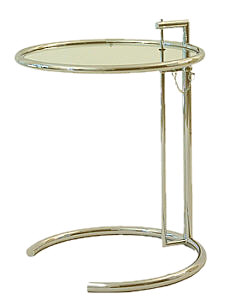 W
WTable E 1027 is an adjustable steel and glass table designed by Irish designer Eileen Gray in 1927. Originally created for her E-1027 house, the table has since become one of Gray's most famous designs.
 W
WAn altar is a structure with an upper surface for the presentation of religious offerings, for sacrifices, or for other ritualistic purposes. Altars are found at shrines, temples, churches, and other places of worship. They are used particularly in Paganism, Christianity, Buddhism, Hinduism, Judaism, and Modern Paganism. Many historical faiths also made use of them, including the Roman, Greek, and Norse religions.
 W
WThe An is a small table, desk or platform used during Shinto ceremonies to bear offerings. It may have four, eight or sixteen legs; the eight-legged variety, called hassoku-an or hakkyaku-an , is the most common.
 W
WA billiard table or billiards table is a bounded table on which cue sports are played. In the modern era, all billiards tables provide a flat surface usually made of quarried slate, that is covered with cloth, and surrounded by vulcanized rubber cushions, with the whole thing elevated above the floor. More specific terms are used for specific sports, such as snooker table and pool table, and different-sized billiard balls are used on these table types. An obsolete term is billiard board, used in the 16th and 17th centuries.
 W
WChabudai is a short-legged table used in traditional Japanese homes. The original chabudai ranged in height from just 15 cm to a maximum height of 30 cm. People seated at a chabudai may sit on zabuton or tatami rather than on chairs. The four legs of a chabudai are generally collapsible so that the table may be moved and stored easily.
 W
WA changing table is a small raised platform designed to allow a person to change someone's diaper.
 W
WA chess table is a table built with features to make it useful for playing the game of chess. A chess board is usually integral to the table top and often two drawers are provided to hold the pieces when not in use. Chess tables can be extremely decorative, well made and potentially expensive pieces of furniture. Most chess tables have the board inlaid or engraved though cheaper tables may have it painted on. A chess table is not necessary to play chess and is not restricted only to playing chess.
 W
WThis carved lacquerware table in the Victoria and Albert Museum in London is from the Ming dynasty (1368–1644). It is unique in shape and decoration and is one of the most important objects from the period. It is one of the few surviving examples in the world of a major piece of furniture produced in the 'Orchard Workshop', the Imperial lacquer workshop set up in the early Ming period and situated to the north-west of the 'Forbidden City' compound in Peking.
 W
WA coffee table is a low table designed to be placed in a sitting area for convenient support of beverages, remote controls, magazines, books, decorative objects, and other small items.
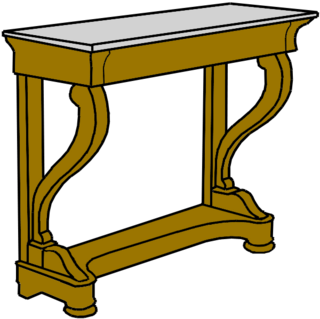 W
WA console table is a table whose top surface is supported by corbels or brackets rather than by the usual four legs. It is thus similar to a supported shelf and is not designed to serve as a stand-alone surface. It is frequently used as pier table, to abut a pier wall.
 W
WA credence table is a small side table in the sanctuary of a Christian church which is used in the celebration of the Eucharist..
 W
WA drawing board is, in its antique form, a kind of multipurpose desk which can be used for any kind of drawing, writing or impromptu sketching on a large sheet of paper or for reading a large format book or other oversized document or for drafting precise technical illustrations. The drawing table used to be a frequent companion to a pedestal desk in a study or private library, during the pre-industrial and early industrial era.
 W
WA drop-leaf table is a table that has a fixed section in the center and a hinged section (leaf) on either side that can be folded down (dropped). If the leaf is supported by a bracket when folded up, the table is simply a drop-leaf table; if the leaf is supported by legs that swing out from the center, it is known as a gateleg table. Depending on the style of drop-leaf or gateleg tables, the leaves vary from coming almost down to the floor to only coming down slightly.
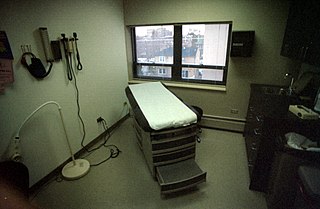 W
WAn examination table is used to support patients during medical examinations. During these exams, doctors in offices, clinics and hospitals use an adjusting mechanism to manipulate and position the table to allow patient support, closer examination of a portion or the entire patient, and the ability to move the patient on and off the table safely. Examination tables often have rolls of paper which the patient sits or lies on, to protect the table. The paper is normally discarded after each patient uses the table.
 W
WA gateleg table is a type of furniture first introduced in England in the 16th century. The table top has a fixed section and one or two hinged leaves, which, when not in use, fold down below the fixed section to hang vertically.
 W
WA guéridon is a small table supported by one or more columns, or sculptural human or mythological figures, often with a circular top. The guéridon originated in France towards the middle of the 17th century. The supports for early guéridons were often modeled on ancient Egyptian and Greek as well as various African human traditional figures.
 W
WThe High table is a table for the use of fellows and their guests in large dining halls, where the students eat in the main space of the hall at the same time. They remain the norm at Oxford, Cambridge, Dublin and Durham universities, where the university is organized into colleges. Other academic institutions also have high tables.
 W
WA korsi or korsí is a type of low table found in Iran, with a heater underneath it, and blankets thrown over it. It is a traditional item of furniture in Iranian culture. A family or other gathering sits on the floor around the korsi during the winter. A korsi used to be quite popular for entire families to gather together during yearly Yaldā celebrations.
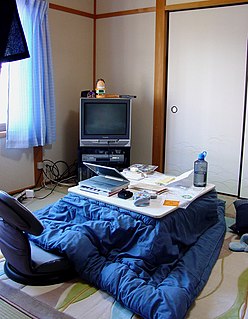 W
WA kotatsu is a low, wooden table frame covered by a futon, or heavy blanket, upon which a table top sits. Underneath is a heat source, formerly a charcoal brazier but now electric, often built into the table itself. Kotatsu are used almost exclusively in Japan, although similar devices for the same purpose of heating are used elsewhere, e.g. the Spanish brasero or Iranian korsi.
 W
WLoo table is a table model from the 18th and 19th centuries, originally designed for the card game loo, which was also known as lanterloo.
 W
WA monks bench or hutch table is a piece of furniture where a tabletop is set onto a chest in such a way that when the table was not in use, the top pivots to a vertical position and becomes the back of a Settle, and this configuration allows easy access to the chest lid which forms the seat of the piece. Percy Blandford notes that "whether monks ever used such a bench is debatable, but it is an attractive name".
 W
WA nightstand, alternatively night table, bedside table, daystand or bedside cabinet, is a small table or cabinet designed to stand beside a bed or elsewhere in a bedroom. Modern nightstands are usually small bedside tables, often with one or sometimes more drawers and/or shelves and less commonly with a small door. They are often used to support items that might be useful during the night, such as a table lamp, alarm clock, reading matter, cell phone, eyeglasses, tissues, sex toys, a drink, or medication.
 W
WThe Noguchi table is a piece of modernist furniture first produced in the mid-20th century. Introduced by Herman Miller in 1947, it was designed in the United States by Japanese American artist and industrial designer Isamu Noguchi. The Noguchi table comprises a wooden base composed of two identical curved wood pieces, and a heavy plate glass top.
 W
WAn optical table is a vibration control platform that is used to support systems used for laser- and optics-related experiments, engineering and manufacturing. The surfaces of these tables are designed to be very rigid with minimum deflection so that the alignment of optical elements remains stable over time. Many optical systems require that vibration of optical elements be kept small. As a result, optical tables are typically very heavy and incorporate vibration isolation and damping features in their structure. Many use pneumatic isolators that act as mechanical low-pass filters, reducing the ability of vibrations in the floor to cause vibrations in the tabletop.
 W
WThe Parsons table is a modernist square or rectangular table whose four legs are square in cross-section, flush with the edges of the top, and equal to it in thickness.
 W
WA picnic table is a table with benches, designed for impromptu outdoor dining. The term is often specifically associated with rectangular tables having an A-frame structure. Such tables may be referred to as "picnic tables" even when used exclusively indoors.
 W
WA pier table is a table designed to be placed against a wall, either between two windows or between two columns. It is also known as a console table.
 W
WA poker table or card table is a table specifically designed for playing card games.
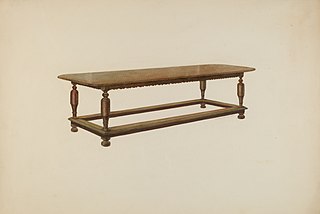 W
WA refectory table is a highly elongated table used originally for dining in monasteries during Medieval times. In the Late Middle Ages, the table gradually became a banqueting or feasting table in castles and other noble residences. The original table manufacture was by hand and created of oak or walnut; the design is based on a trestle style. Typically, the table legs are supported by circumferential stretchers positioned very low to the floor.
 W
WThe Round Table is King Arthur's famed table in the Arthurian legend, around which he and his knights congregate. As its name suggests, it has no head, implying that everyone who sits there has equal status. The table was first described in 1155 by Wace, who relied on previous depictions of Arthur's fabulous retinue. The symbolism of the Round Table developed over time; by the close of the 12th century it had come to represent the chivalric order associated with Arthur's court, the Knights of the Round Table.
 W
WA round table is a table which has no "head" and no "sides", and therefore no one person sitting at it is given a privileged position and all are treated as equals. The idea stems from the Arthurian legend about the Knights of the Round Table in Camelot.
 W
WA sewing table or work table is a table or desk used for sewing. Generally it has large amounts of space and a full set of sewing tools. Nearby there will be a chair and a waste bin. A common attachment is a dropleaf to give expanded space. Other attachments can be a cloth bag for storing sewing materials, drawers, or shelves.
 W
WA Stammtisch is an informal group meeting held on a regular basis, and also the usually large, often round table around which the group meets. A Stammtisch is not a structured meeting, but rather a friendly get-together.
 W
WTablescaping, or table-setting, is an activity involving the setting of themed dining tables in artful, decorative ways for social events, and in a variety of categories for competitions. Tablescaping is a portmanteau of table and landscaping; it was coined by television chef Sandra Lee in 2003. In the United States, competitions take place at county fairs, and events across the country; competitive tablescaping traces back to at least the 1930s. The creations are “rigorously judged” with points lost for glassware, cutlery, and plates, and other items missing or out of place, while points can be gained for creativity or interpretation of a theme. Other criteria considered can include aesthetics, functionality, balance, and the corresponding fictional menu that would accompany the table’s meal; an entry can use a formal table setting, or be quite casual depending on the theme. The practice has become better known since the rise in social media posts centered on meals people share including the setting; on photo-sharing Instagram, as of November 2019, #tabledecor has 1.9 million posts, and #tablesetting has 2.3 million posts. A counterintuitive trend is for a rustic or farm theme, with a sustainability aesthetic emphasizing materials and components that are recycled, and upcycled.
 W
WA Tapchan (топчан) is a type of outdoor furniture unique to Central Asia especially Tajikistan and Uzbekistan, combining a large bed capable of holding 4-8 adults with a table at which meals can be eaten.
 W
WA teapoy is an item of furniture. The word is of Indian origin, and was originally used to describe a three-legged table.
 W
WA trestle support is a structural element with rigid beams forming the equal sides of an isosceles triangle, joined at their apices by a plank or beam. Sometimes additional rungs are stretched between the two beams. A pair of trestle legs can support one or several boards or planks, forming a trestle table or trestle desk. A network of trestle supports can serve as the framework for a trestle bridge. A trestle of appropriate size to hold wood for sawing is known as a sawhorse.
 W
WA trestle table is a table consisting of two or three trestle supports, often linked by a stretcher, over which a board or tabletop is placed. In the Middle Ages, the trestle table was often little more than loose boards over trestle legs for ease of assembly and storage. This simple, collapsible style remained the most common Western form of table until the 16th century, when the basic trestle design gave way to stronger frame-based structures such as gateleg and refectory tables. Ease of assembly and storage has made it the ideal occasional table, and it remains a popular form of dining table, as those seated are not so inconvenienced as they might be with the more usual arrangement of a fixed leg at each corner.
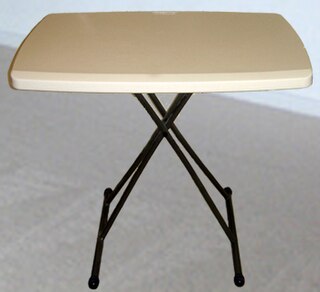 W
WA TV tray table, TV dinner tray, or personal table is a type of collapsible furniture that functions as a small and easily portable, folding table. These small tables were originally designed to be a surface from which one could eat a meal while watching television. The phrase tray-table can also refer to a fold-away tray, such as those found in front of airline seats.
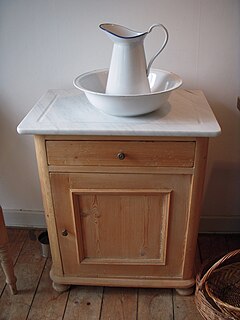 W
WA washstand or basin stand is a piece of furniture consisting of a small table or cabinet, usually supported on three or four legs, and most commonly made of mahogany, walnut, or rosewood, and made for holding a wash basin and water pitcher. The smaller varieties were used for rose-water ablutions, or for hair-powdering. The larger ones, which possessed receptacles for soap-dishes, were the predecessors of the modern bathroom wash basin, or sink. Both varieties, often of very elegant form, were in extensive use throughout a large part of the 18th century and early-19th century, eventually disappearing with the advent of modern indoor plumbing.
 W
WA writing table has a series of drawers directly under the surface of the table, to contain writing implements, so that it may serve as a desk. Antique versions have the usual divisions for the inkwell, the blotter and the sand or powder tray in one of the drawers, and a surface covered with leather or some other material less hostile to the quill or the fountain pen than simple hard wood.